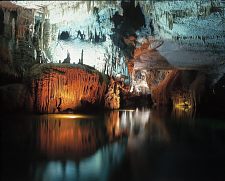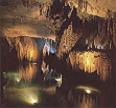Jeita Grotto
Profile Altitude:
186m
Distance from Beirut: 23km
Getting there
From Beirut, go north, through Nahr El Kalb tunnel, turn right to Ajaltoun, and
to Jeita Grotto. |

|
Few caverns in the
world approach the astounding wealth or the extent of those of Jeita. In these
caves and galleries, known to man since Paleolithic times, the action of water
has created cathedral-like vaults beneath the wooded hills of Mount Lebanon.
Geologically, the
caves provide a tunnel or escape route for the underground river, which is the
principal source of the Nar el-Kalb (Dog River). Located some 20 kilometers
along the highway North of Beirut, a large sign indicates the right turn from
Zouk Mickael village, just beyond the tunnel. The caverns are on two levels.
The lower galleries, discovered in 1836 and opened to the public in 1958, are
visited by boat. The upper galleries, opened in January 1969, can be seen on
foot.
To mark the inauguration of the upper galleries, arranged by the Lebanese
artist and sculptor Ghassan Klink, a concert was organized in the cave
featuring electronic music by the French composer François Bayle. Other
cultural events have taken place in this unusual venue, including a concert by
the German composer Carl-Heinrich Stochhausen in November 1969.
Jeita remained a popular attraction until the recent Lebanese conflict forced
it to close in the mid 1970’s. Upon the initiative of Minister of Tourism
Nicolas Fattouche, the Ministry charged the German company "Mapas" to renovate
and re-equip its facilities by the most modern techniques and to operate the
complex. On July 6, 1995, this natural wonder was again open to the public.
Inside The Caves
 |
|
In summer you can visit both the upper and lower galleries while enjoying the
refreshingly cool temperature inside the caves. The lower section is sometimes
closed in winter when the water level is high, but the extensive upper
galleries are open all year.
Plan on about two hours for the tour, which includes a boat ride through the
lower galleries, the visit to the upper galleries on foot and a film
presentation.
|
Jeita Rediscovered
The modern discovery
of the underground river of Jeita dates to 1836 and is attributed to Reverend
William Thomson, an American missionary who ventured some 50 meters into the
cave. Reaching the underground river, he fired a shot from his gun and the
resulting echoes convinced him that he had found a cavern of major importance.
In 1873 W.J. Maxwell
and H.G. Huxley, engineers with the Beirut Water Company, and their friend
Reverend Daniel Bliss, president of the Syrian Protestant College (later the
American University of Beirut) explored these caverns. In two expeditions
carried out in 1873 and 1874 they penetrated 1,060 meters into the
grotto-principal source of the Nahr el-Kalb that supplies Beirut with water.
They were finally stopped by "Hell's Rapids", where the river flows in torrents
over razor sharp rocks.
Like explorers
everywhere, Dr. Bliss, Mr. Maxwell and the other engineers could not resist
recording their names and the year on "Maxwell's Column", a great limestone
pillar some 625 meters from the entrance.
About 200 meters
further on, in the so-called "Pantheon', they wrote their names and details of
the expedition on paper, sealed it in a bottle and placed it on top of a
stalagmite. The action of the lime- impregnated water has since covered the
bottle with a thin white film, permanently fixing it to the stone. Between 1892
and 1940 further expeditions were carried out, mostly by English, American or
French explorers. These efforts brought them to a depth of 1,750 meters.
Since the 1940's,
Lebanese explorers, notably the members of the Speleo-Club of Lebanon founded by
the first Lebanese speleologist Lionel Ghorra, have pushed even deeper into the
Jeita grotto. Their methodical exploration revealed the great underground system
of the upper and lower galleries which is now known to a depth approaching 9
kilometers.
The upper galleries,
discovered in August 1958 by Lebanese speleologists, required a hazardous climb
to 650 meters above the entrance of the underground river. Altogether, 2,130
meters of this gallery have been explored.
Information From the Ministry of
Tourism

|